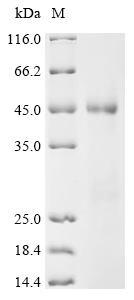Recombinant Human Pulmonary surfactant-associated protein A2 (SFTPA2) is produced using a mammalian cell expression system and comes with a C-terminal hFc1 tag. This partial protein covers amino acids 141-248. SDS-PAGE analysis confirms the purity level exceeds 85%. The protein is designed for research use only, though no specific endotoxin level data appears to be available.
Pulmonary surfactant-associated protein A2 seems to play a crucial role in maintaining surfactant balance and supporting immune defense in the lungs. It's considered a key component of the pulmonary surfactant system, helping to reduce surface tension in the alveoli while participating in innate immune responses. Understanding this protein may prove vital for respiratory physiology research and disease studies.
Potential Applications
Note: The applications listed below are based on what we know about this protein's biological functions, published research, and experience from experts in the field. However, we haven't fully tested all of these applications ourselves yet. We'd recommend running some preliminary tests first to make sure they work for your specific research goals.
Based on the provided information, the folding state and bioactivity of this recombinant SFTPA2 protein fragment are unknown and must be considered highly uncertain. SFTPA2 is a member of the collectin family, and its function critically depends on the correct folding of its C-terminal carbohydrate recognition domain (CRD) and the formation of higher-order oligomeric structures (trimers and larger multimers). The protein is expressed as a partial fragment (141-248aa), which corresponds primarily to the CRD but lacks the N-terminal collagen-like domain that is essential for the native quaternary structure and full function. Expression in a mammalian system is favorable for disulfide bond formation in the CRD, but the large C-terminal hFc1 tag is highly likely to sterically interfere with the CRD's ligand-binding site and prevent proper oligomerization. Therefore, it is highly improbable that this protein is correctly folded into a bioactive conformation that replicates native SFTPA2 function. Applications relying on specific biological interactions are not feasible without validation.
1. Antibody Development and Validation Studies
This recombinant SFTPA2 fragment is suitable for use as an immunogen to generate antibodies. The mammalian expression system may promote correct disulfide bonding within the CRD. Antibodies generated will be against this truncated, Fc-tagged fragment. Their ability to recognize the complex, oligomeric structure of full-length, native SFTPA2 in lung surfactant is very low and must be rigorously validated. The protein is most reliable for developing antibodies that detect denatured SFTPA2 (e.g., in Western blots) or the recombinant human SFTPA2 protein itself.
2. ELISA-Based Quantitative Assays
The hFc1-tagged protein can be used in ELISA. However, it is critically important to understand its severe limitation: it is not suitable for measuring SFTPA2 levels in biological samples. An ELISA built with this recombinant SFTPA2 protein would only detect the fragment or antibodies against it. It would not accurately quantify the native, oligomeric full-length SFTPA2 present in bronchoalveolar lavage fluid, as the epitopes are completely different. Its use should be restricted to detecting antibodies against the immunogen.
3. Biochemical Characterization and Stability Studies
This purified recombinant fragment is well-suited for basic biochemical characterization of the isolated CRD domain. Studies on its thermal stability, glycosylation, and protease sensitivity can be performed. This application is valid for studying the properties of this specific recombinant SFTPA2 fragment, not the full-length, oligomeric native protein.
Final Recommendation & Action Plan
The unequivocal recommendation is to restrict the use of this recombinant SFTPA2 protein lot to applications that do not depend on native oligomeric structure or function. It can be used for generating antibodies against linear epitopes of the CRD (Application 1, with the stated limitations) and for characterizing the biophysical properties of the isolated, tagged CRD fragment itself (Application 3). The recombinant SFTPA2 fragment lacks the collagen-like domain necessary for native oligomerization, and the Fc tag will likely block the CRD's binding site. So protein-protein interaction studies and functional studies must be abandoned entirely, as they will produce biologically meaningless and misleading data. For any functional studies related to SFTPA2 (e.g., pathogen binding, surfactant interactions), a full-length protein without a large C-terminal tag, expressed in a system conducive to correct oligomerization, is essential.






